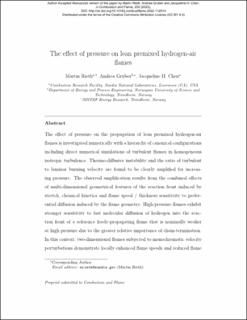| dc.contributor.author | Rieth, Martin | |
| dc.contributor.author | Gruber, Andrea | |
| dc.contributor.author | Chen, Jacqueline H. | |
| dc.date.accessioned | 2024-01-22T12:52:37Z | |
| dc.date.available | 2024-01-22T12:52:37Z | |
| dc.date.created | 2023-02-14T08:46:04Z | |
| dc.date.issued | 2023 | |
| dc.identifier.issn | 0010-2180 | |
| dc.identifier.uri | https://hdl.handle.net/11250/3113140 | |
| dc.description.abstract | The effect of pressure on the propagation of lean premixed hydrogen-air flames is investigated numerically with a hierarchy of canonical configurations including direct numerical simulations of turbulent flames in homogeneous isotropic turbulence. Thermo-diffusive instability and the ratio of turbulent to laminar burning velocity are found to be clearly amplified for increasing pressure. The observed amplification results from the combined effects of multi-dimensional geometrical features of the reaction front induced by stretch, chemical kinetics and flame speed / thickness sensitivity to preferential diffusion induced by the flame geometry. High-pressure flames exhibit stronger sensitivity to fast molecular diffusion of hydrogen into the reaction front of a reference freely-propagating flame that is nominally weaker at high pressure due to the greater relative importance of chain-termination. In this context, two-dimensional flames subjected to monochromatic velocity perturbations demonstrate locally enhanced flame speeds and reduced flame thickness at high pressure in regions of curvature that are convex towards the reactants. Furthermore, it is found that a Peclet number definition, based on the ratio of diffusive to convective time scales, provides a satisfactory global representation of pressure effects upon thermo-diffusive instabilities of freely-propagating flames. Finally, employing a series of carefully designed direct numerical simulations, it is empirically demonstrated that very similar flame responses can be obtained at atmospheric and pressurized conditions by approximately matching a selection of four key parameters ( , , , ). This key finding demonstrates that the flame speed enhancement often observed at elevated pressure is not a pressure effect per se, but rather determined by the sensitivity of the flame to preferential diffusion ( ) versus its own reactivity ( ), with nominally ‘weaker’ flames showing stronger sensitivity. | en_US |
| dc.description.abstract | The effect of pressure on lean premixed hydrogen-air flames | en_US |
| dc.language.iso | eng | en_US |
| dc.publisher | Elsevier | en_US |
| dc.rights | Navngivelse 4.0 Internasjonal | * |
| dc.rights.uri | http://creativecommons.org/licenses/by/4.0/deed.no | * |
| dc.title | The effect of pressure on lean premixed hydrogen-air flames | en_US |
| dc.title.alternative | The effect of pressure on lean premixed hydrogen-air flames | en_US |
| dc.type | Peer reviewed | en_US |
| dc.type | Journal article | en_US |
| dc.description.version | acceptedVersion | en_US |
| dc.rights.holder | The Authors hold the copyright to the Author Accepted Manuscript. Distributed under the terms of the Creative Commons Attribution License (CC BY 4.0) | en_US |
| dc.source.volume | 250 | en_US |
| dc.source.journal | Combustion and Flame | en_US |
| dc.identifier.doi | 10.1016/j.combustflame.2022.112514 | |
| dc.identifier.cristin | 2125825 | |
| dc.relation.project | Sigma2: ns9121k | en_US |
| dc.relation.project | Sigma2: nn9527k | en_US |
| dc.relation.project | Norges forskningsråd: 257579 | en_US |
| dc.source.articlenumber | 112514 | en_US |
| cristin.ispublished | true | |
| cristin.fulltext | postprint | |
| cristin.qualitycode | 2 | |

